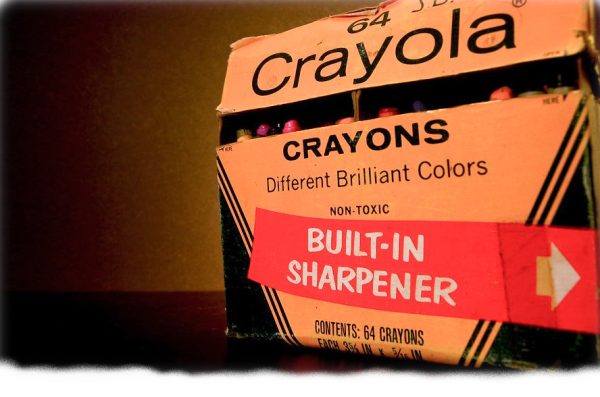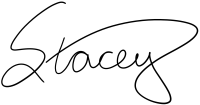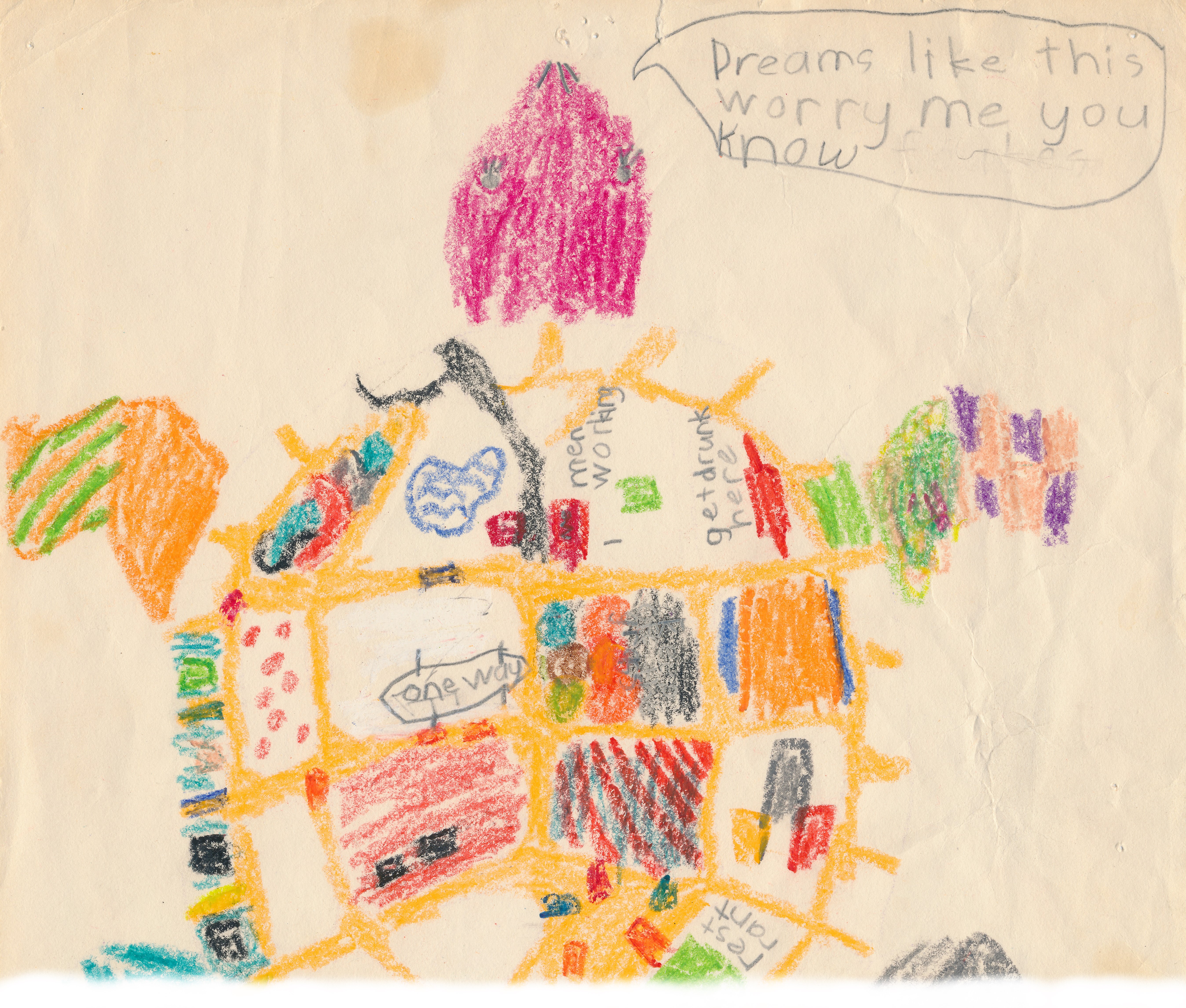Crayons

3 June 2019 | Theme: Creativity | 7-Minute Read | Listen
When I was in elementary school, summer days seemed to stretch to infinity. One day of eating honeysuckle nectar rolled into the next day of lying on a blanket, looking for shapes in clouds. If I rest for a moment and let my mind journey back, I can see my thumbnails, stained green from pinching flower stems to make chains; I can smell the pungent-sweet scent of clover. The grass and dirt are cool beneath my back, and my skyward-turned face is warm.
By the middle of July, newspapers would begin to herald a return to more structured days ahead with their “back-to-school” ads. Where most kids avoided the news of returning to the classroom, I secretly rejoiced. I loved going back to school!
Every year, I could hardly wait to shop for new school supplies. I’d eagerly scan the teacher-provided list for new and unusual items: scissors with an actual point, “real” pencils to replace the large Laddie pencils used in kindergarten, notebook paper instead of Big Chief tablets… and every year, a new box of crayons.
Oh, the magic of a new box of crayons! I would skip down the school supply aisle and gather up items, taking care to get exactly what was on the list. But when it was time for the crayons, I would hesitate and hover over the giant box with metallic copper, silver, and gold—the one with the built-in sharpener. Oh, what I could do with that set of crayons!
Each August, my mother would patiently point out that the teacher had asked us to get the box of 24 crayons, and if I were to get the 64-crayon box, other children might feel left out. We should get the same ones as everyone else, she reasoned. If I had needed the deluxe box, the teacher would have listed the deluxe box.
One year, my mother must have been distracted with my older brothers’ supply lists, because she finally allowed me to get “The Big Box.” I was overjoyed! I must have arranged and re-arranged my new supplies a dozen times before the first day of school, and each time, I’d open the box of crayons and look at their perfect, pristine tips. I would inhale the aroma of colored wax, and I’d put my finger into the built-in sharpener. With that set of crayons, I was going to create something A-Maz-Ing, I just knew it.
I could hardly wait for the first day of school, and when it arrived, I eagerly boarded the school bus. I met my teacher, found my seat, and began to write my name on all those supplies. It felt as if hours went by before we were finally instructed to draw a picture of what we had done over the summer. Huzzah! Crayon time!
Dozens of images filled my head, so I tried to imagine how I would capture each of them. Slowly, I removed a brand-new crayon from the box and made a first tentative mark. Oh, no! That wasn’t quite it! Another mark, this time a curve, and it wasn’t quite right, either.
Line after line, I tried to make the picture on the paper look like the image in my head, but nothing was as I wanted it to be. The brand-new crayons, some now sporting slightly-worn tips, had already lost their charm—and I hadn’t even use the gold one yet!
How had that happened so quickly? A magical box filled with infinite possibilities had already become a plain old set of crayons. I looked over at the beautiful picture Denelda was drawing. When she colored, the pigment on the paper was smooth and perfect. Mine showed little scratches this direction and that. Suddenly, I just knew it: I Can’t Draw. The pictures in my head were going to remain locked there, because my hands wouldn’t communicate with my head to bring those ideas into the world. At least, not the way I saw it.
Being dissatisfied with the results of our artistic endeavors is commonplace, I know as an adult. Denelda’s picture looked perfect to me, but likely, she was as unhappy with her work as I was with mine. We all see the flaws in our own work, the places where it doesn’t meet our internal expectations. We are all our own worst critics.
A Facebook friend of mine recently posted that she has become dissatisfied with her art, questioning everything and wondering whether she will ever be satisfied with what she’s producing. Lots of artistic friends replied to her that, yup, that’s pretty standard. One wise friend, Robyn, said, “The artist who loves everything they make is either a saint of self-acceptance or someone with zero standards.” She went on to say that out of 50 things, she might truly like only one, but the other 49 made it possible to get to that one.
In his blog “Discover How to Be More Creative,” Tanner Christensen points out, “In order for you to hate the work you create—whether it’s artwork, writing, music, anything—you have to actually create it first. And behind that process there are a lot of ugly obstacles and challenges.”
Hmm. So the only solution to hating the things we make is to keep making them. No wonder so many Creatives have gone stark raving mad!
I am fortunate that my creativity didn’t get closed into that yellow-and-green-box-with-the-built-in-sharpener. I had the dollhouse, and a choir, and creative writing, and cooking, and song writing, and more. I knew I was a creative person. I was just a creative person who couldn’t draw. At least, that was the story I told myself and believed for decades.
My friend Gwenda recently told me that she theorizes that you can tell when a person first believed the story of not being good at drawing by the way they draw as an adult. She posits that a person’s drawing ability is frozen at the age they were when they gave up.
So you know what I’m going to do? I’m going to go out to the store today and buy some crayons. I’m getting the Big Box, sharpener and all, and I’m going to draw something. Anything. It’ll probably look like an elementary kid’s drawing, but it’s my opportunity to rewrite—or redraw—the story I’ve told myself for decades. I’m going to look at it, see its flaws, and hang it on the refrigerator anyway!
Until next time,

If you enjoyed this article,
please share on social media!
NEXT ARTICLE

My Brother’s Turtles
11 June 2019 | Theme: Getting Started | 7-Minute Read
The instructions were straightforward enough: color the turtle. My second-grade brother Scott looked at the sheet of paper with the mimeographed turtle outline and considered the possibilities. It was a top-down view of the turtle so that all four legs were visible, and its head and tail protruded from the sectioned-off shell. “Color the turtle?” SURE! Scott set out to use as many . . .